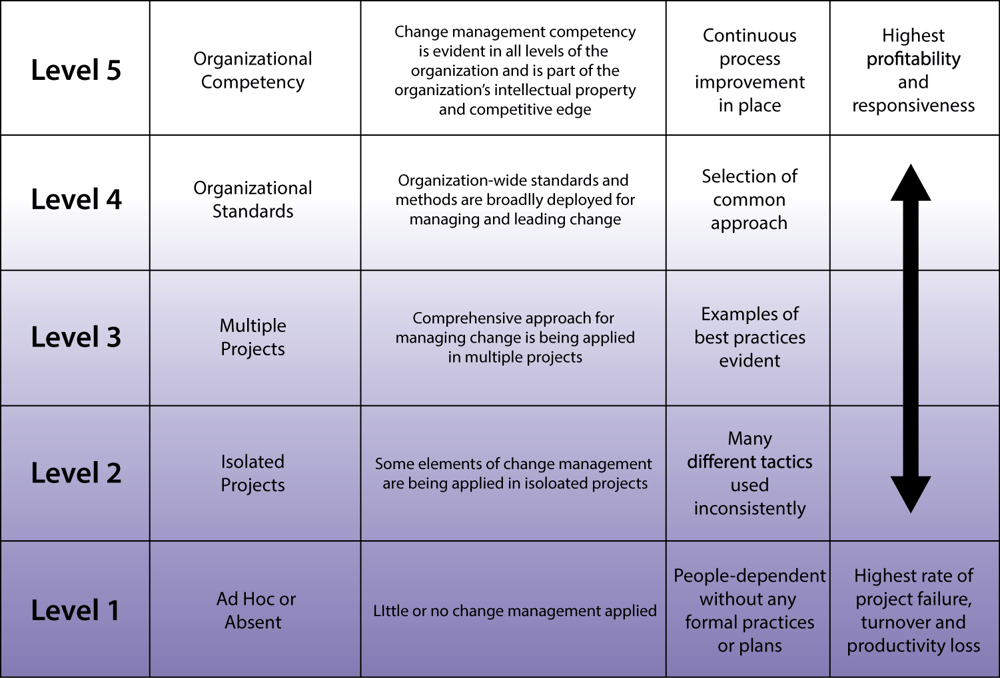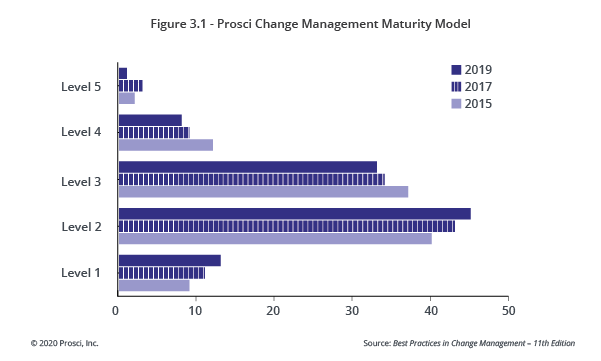Review Project Management Maturity Models Side by Side
Organizations are facing larger and more frequent changes in the current economic climate. A irresolute marketplace, empowered workforce and technological advancements have created an environment where change is now a part of everyday business organization. In this environment, organizations are beginning to recognize the importance of edifice the competency to chop-chop and successfully change. Prosci's Alter Direction Maturity Model, based on benchmarking research, describes the varying levels of alter management capabilities beyond organizations. The maturity model has five levels, ranging from no alter management to organizational competency. Each level involves more attending and management of the people side of change. Below is a detailed explanation of each level also as the activeness steps your organization can take to movement to the next level of the model. The article concludes with enquiry data on Maturity Model levels from All-time Practices in Change Management - 11th Edition . At Level 1 of the organizational alter management maturity model, projection teams are non aware of change management and practice not consider it as a formal arroyo for managing the people side of modify. Use at the Projection Level:Alter direction is applied on a project only as a last resort when employee resistance jeopardizes the success of the project. Change management is reactive and an improver to the project. No integration with projection management takes place at the kickoff of the projection. Projects at this level can have 1 or more than of the following characteristics: In Level 2, elements of change direction begin to emerge in isolated parts of the organization. The effort to manage the people side of change is infrequent and is not centralized. Characteristics of this level are: In Level 2, projects apply change management when resistance emerges or when the project nears implementation. Just isolated projects use change management at the beginning of their project. Some elements of communication planning occur early in the lifecycle. At this stage, change direction is not fully integrated into project management. On projects that use change management, the project team is enlightened and knowledgeable of alter direction. In certain instances, a alter management advocate can encourage the integration of change management and project management. At Level three, groups emerge that brainstorm using a structured change management process. Modify management is still localized to particular teams or areas in the organization. Organizations at this level tin have one or more of the following characteristics: Alter direction is initiated at the start of some projects, with a big fraction withal applying change management as a reaction to employee resistance during implementation. Teams who are successful at change management integrate change management with their overall projection direction methodology at the inception of the project, including communication and other change direction plans. In Level 4 of the Modify Direction Maturity Model, the organization has selected a common arroyo and implemented standards for using change management on every new project or modify. Annotation: a mutual methodology does non hateful a one-size-fits-all recipe; effective methodologies use repeatable steps, but they work best when tailored to the specific needs of every project. Organizations at this level can have one or more than of the following characteristics: At Level iv, teams regularly utilize a change direction approach from the beginning of their project, with change management work included in the planning phase of the project. As the projection progresses, project management and change management proceed to integrate to the point where they are non separable. Project teams follow both project and modify management milestones. In Level 5 change management maturity, change management competency is role of the skill ready of the arrangement. Organizations at this level can have one or more than of the following characteristics: When organizations have developed a high level of alter management competency, change direction steps are completely integrated into project management, and alter management work begins before the projection kicks off. Planning and design phases accept both projection and alter management elements and are viewed every bit standard practice. In Prosci'due south Best Practices research, participants identified where they were on the Change Management Maturity Model. Only under half of participants (49%) brutal at Level 1 (Ad hoc or absent modify management) or Level 2 (change management on isolated projects). But xiv% were at Level 4 or Level 5, where the arrangement had truly begun adopting organizational standards and building organizational competencies. Moving up the Modify Direction Maturity Model improves how an organization operates and performs during times of modify. At that place is a growing body of cognition that shows a directly correlation between how well an organization manages the people side of alter and how successful projects and initiatives ultimately are. As an organization sees examples of failed changes due to poorly managed change and successes due to effectively managed change, there is a greater sense of urgency related to moving up the Maturity Model.
Level i: Ad Hoc or Absent-minded Change Direction
Level one integration between project management and alter management
Steps for moving to Level 2
Level 2: Alter Direction on Isolated Projects
Level ii change management and project management integration
Steps for moving to Level 3 maturity

Level iii: Change Management on Multiple Projects
Level three project management and change management integration
Steps for moving to Level 4 maturity
Level four: Organizational Change Management Standards
Level iv projection management and change management integration
Steps for moving to Level v
Level v: Organizational Competency
Level 5 project management and change management integration
Change Management Maturity Model Benchmarking Research

Side by side Steps to Attain Organizational Change Management Maturity
Source: https://www.prosci.com/resources/articles/change-management-maturity-model
0 Response to "Review Project Management Maturity Models Side by Side"
Post a Comment